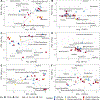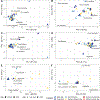An exploratory spatial contaminant assessment for polar bear (Ursus maritimus) liver, fat, and muscle from northern Canada
- PMID: 36395907
- PMCID: PMC10163957
- DOI: 10.1016/j.envpol.2022.120663
An exploratory spatial contaminant assessment for polar bear (Ursus maritimus) liver, fat, and muscle from northern Canada
Abstract
Since the industrial era, chemicals have been ubiquitous in worldwide ecosystems. Despite the discontinued release of highly toxic persistent organic pollutants (POPs) in the environment, the levels of some POPs are still being measured in the Canadian Arctic. These contaminants are of great concern due to their persistence, toxicity, and levels of bioaccumulation in food chains. Animals occupying top trophic positions in the Canadian Arctic, particularly polar bears, are exposed to these contaminants mainly through their diet. Our study investigated the levels of 30 metals (including total and methyl mercury) alkaline and alkaline earth metals, 15 polycyclic aromatic compounds and their alkyl congeners (PACs), 6 chlordanes (CHLs), and 20 polychlorinated biphenyls (PCBs), in 49 polar bears from the Canadian Arctic. Contaminant burden was measured in liver, muscle, and fat in bears of different sex, age, and locations. A principal component analysis did not distinguish differences between age and sex profiles for most contaminants. However, the concentrations measured and their distribution in the tissues confirm findings observed in past studies. This study highlights the importance of continual monitoring of polar bear health (e.g., newly detected PACs were measured within this study) and evaluating those impacts for the next generations of polar bears.
Keywords: Arctic; Metals; Persistent organic compounds; Pesticides; Polychlorinated biphenyls; Polycyclic aromatic compounds.
Copyright © 2022 Elsevier Ltd. All rights reserved.
Conflict of interest statement
Declaration of competing interest The authors declare that they have no known competing financial interests or personal relationships that could have appeared to influence the work reported in this paper.
Figures



References
-
- Arctic Monitoring Assessment Program, 2018. AMAP Assessment 2018: Biological Effects of Contaminants on Arctic Wildlife and Fish.
-
- Arctic Monitoring Assessment Program, 2017. AMAP Assessment 2016: Chemicals of Emerging Arctic Concern.
-
- Auger-Méthé M, Lewis MA, Derocher AE, 2016. Home ranges in moving habitats: Polar bears and sea ice. Ecography (Cop.). 39, 26–35. 10.1111/ecog.01260 - DOI
MeSH terms
Substances
Grants and funding
LinkOut - more resources
Full Text Sources
Miscellaneous

